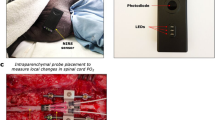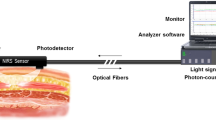Abstract
We aimed to assess the ability of near-infrared spectroscopy (NIRS) to detect spinal cord ischemia, and to evaluate changes in regional oxygen saturation (rSO2) following recovery of spinal cord circulation and cerebrospinal fluid drainage. Four 12-month-old female swine weighing 28.7–29.5 kg were acquired for this study. NIRS probes were placed along the midline of the upper (T6/7) and lower (T9/T10) thoracic vertebrae. The thoracic aorta was clamped distal of the left subclavian artery to induce spinal ischemia. Aortic cross-clamping was maintained for 30 min. Fifteen minutes after aortic de-clamping, the cerebrospinal fluid drainage catheter was opened to air, and cerebrospinal fluid drainage was initiated. Following aortic clamping, rSO2 in both upper and lower regions of the spinal cord decreased by 15 % within 5 min and by 20 % within 10 min (relative change). After aortic de-clamping, rSO2 values in both regions returned to baseline within 5 min. No changes in rSO2 in either the upper or lower vertebrae were observed following initiation of cerebrospinal fluid drainage. Histological analysis revealed that ischemic changes had occurred in all spinal levels. NIRS may be used to detect decreases in and recovery of spinal cord circulation following aortic clamping and de-clamping, whereas it may not reflect minor changes in spinal cord circulation due to cerebrospinal fluid drainage. Further clinical studies are required to investigate the potential for NIRS as an index of spinal cord circulation.


Similar content being viewed by others
References
Kouchoukos NT, Masetti P, Rokkas CK, Murphy SF, Blackstone EH. Safety and efficacy of hypothermic cardiopulmonary bypass and circulatory arrest for operations on the descending thoracic and thoracoabdominal aorta. Ann Thorac Surg. 2001;72:699–707.
Estrera AL, Miller CC III, Huynh TT, Porat E, Safi HJ. Neurologic outcome after thoracic and thoracoabdominal aortic aneurysm repair. Ann Thorac Surg. 2001;72:1225–30.
Coselli JS, LeMaire SA, Conklin LD, Koksoy C, Schmittling ZC. Morbidity and mortality after extent II thoracoabdominal aortic aneurysm repair. Ann Thorac Surg. 2002;73:1107–15.
Etz CD, von Aspern K, Gudehus S, Luehr M, Girrbach FF, Ender J, Borger M, Mohr FW. Near-infrared spectroscopy monitoring of the collateral network prior to, during, and after thoracoabdominal aortic repair: a pilot study. Eur J Vasc Endovasc Surg. 2013;46:651–6.
Reuter DG, Tacker WA Jr, Badylak SF, Voorhees WD 3rd, Konrad PE. Correlation of motor-evoked potential response to ischemic spinal cord damage. J Thorac Cardiovasc Surg. 1992;104:262–72.
Schepens MA, Boezeman EH, Hamerlijnck RP, ter Beek H, Vermeulen FE. Somatosensory evoked potentials during exclusion and reperfusion of critical aortic segments in thoracoabdominal aortic aneurysm surgery. J Card Surg. 1994;9:692–702.
Crawford ES, Mizrahi EM, Hess KR, Coselli JS, Safi HJ, Patel VM. The impact of distal aortic perfusion and somatosensory evoked potential monitoring on prevention of paraplegia after aortic aneurysm operation. J Thorac Cardiovasc Surg. 1988;95:357–67.
Harilall Y, Adam JK, Biccard BM, Reddi A. The effect of optimising cerebral tissue oxygen saturation on markers of neurological injury during coronary artery bypass graft surgery. Heart Lung Circ. 2014;23:68–74.
Zheng F, Sheinberg R, Yee MS, Ono M, Zheng Y, Hogue CW. Cerebral near-infrared spectroscopy monitoring and neurologic outcomes in adult cardiac surgery patients: a systematic review. Anesth Analg. 2013;116:663–76.
Daubeney PE, Smith DC, Pilkington SN, Lamb RK, Monro JL, Tsang VT, Livesey SA, Webber SA. Cerebral oxygenation during paediatric cardiac surgery: identification of vulnerable periods using near infrared spectroscopy. Eur J Cardiothorac Surg. 1998;13:370–7.
Suehiro K, Okutai R. Duration of cerebral desaturation time during single-lung ventilation correlates with mini mental state examination score. J Anesth. 2011;25:345–9.
Suehiro K, Okutai R. Cerebral desaturation during single-lung ventilation is negatively correlated with preoperative respiratory functions. J Cardiothorac Vasc Anesth. 2011;25:127–30.
Murkin JM, Adams SJ, Novick RJ, Quantz M, Bainbridge D, Iglesias I, Cleland A, Schaefer B, Irwin B, Fox S. Monitoring brain oxygen saturation during coronary bypass surgery: a randomized, prospective study. Anesth Analg. 2007;104:51–8.
Hayatsu Y, Kawamoto S, Matsunaga T, Haga Y, Saiki Y. Real-time monitoring of spinal cord blood flow with a novel sensor mounted on a cerebrospinal fluid drainage catheter in an animal model. J Thorac Cardiovasc Surg. 2014;148:1726–31.
LeMaire SA, Ochoa LN, Conklin LD, Widman RA, Clubb FJ Jr, Undar A, Schmittling ZC, Wang XL, Fraser CD Jr, Coselli JS. Transcutaneous near-infrared spectroscopy for detection of regional spinal ischemia during intercostal artery ligation: preliminary experimental results. J Thorac Cardiovasc Surg. 2006;132:1150–5.
Macnab AJ, Gagnon RE, Gagnon FA. Near infrared spectroscopy for intraoperative monitoring of the spinal cord. Spine (Phila Pa 1976). 2002;27(1):17–20.
Demir A, Erdemli O, Unal U, Tasoglu I. Near-infrared spectroscopy monitoring of the spinal cord during type B aortic dissection surgery. J Card Surg. 2013;28:291–4.
Jacobs MJ, Meylaerts SA, de Haan P, de Mol BA, Kalkman CJ. Strategies to prevent neurologic deficit based on motor-evoked potentials in type I and II thoracoabdominal aortic aneurysm repair. J Vasc Surg. 1999;29:48–57.
Jacobs MJ, Mess WH. The role of evoked potential monitoring in operative management of type I and type II thoracoabdominal aortic aneurysms. Semin Thorac Cardiovasc Surg. 2003;15:353–64.
Jacobs MJ, Meylaerts SA, de Haan P, de Mol BA, Kalkman CJ. Assessment of spinal cord ischemia by means of evoked potential monitoring during thoracoabdominal aortic surgery. Semin Vasc Surg. 2000;13:299–307.
Cho H, Nemoto EM, Yonas H, Balzer J, Sclabassi RJ. Cerebral monitoring by means of oximetry and somatosensory evoked potentials during carotid endarterectomy. J Neurosurg. 1998;89:533–8.
Acknowledgments
This study was supported by a Grant-in-Aid for scientific research in Japan [no. J102640032].
Author information
Authors and Affiliations
Corresponding author
Ethics declarations
Conflict of interest
This study complies with the current laws of our country. The contents of this study have not been published elsewhere nor are being submitted elsewhere. The manuscript has been read and approved by all co-authors, and does not have any potential conflicts of interest including commercial relationships such as consultation and equity interests.
Rights and permissions
About this article
Cite this article
Suehiro, K., Funao, T., Fujimoto, Y. et al. Transcutaneous near-infrared spectroscopy for monitoring spinal cord ischemia: an experimental study in swine. J Clin Monit Comput 31, 975–979 (2017). https://doi.org/10.1007/s10877-016-9931-8
Received:
Accepted:
Published:
Issue Date:
DOI: https://doi.org/10.1007/s10877-016-9931-8




